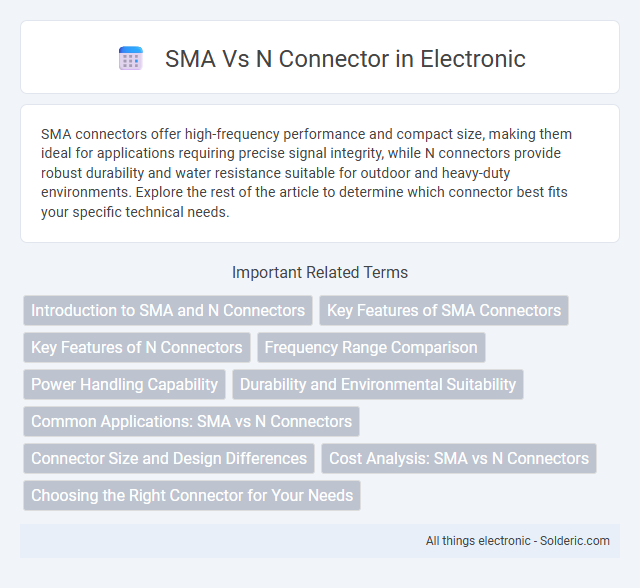SMA connectors offer high-frequency performance and compact size, making them ideal for applications requiring precise signal integrity, while N connectors provide robust durability and water resistance suitable for outdoor and heavy-duty environments. Explore the rest of the article to determine which connector best fits your specific technical needs.
Comparison Table
| Feature | SMA Connector | N Connector |
|---|---|---|
| Frequency Range | DC to 18 GHz (up to 26.5 GHz for precision types) | DC to 11 GHz (up to 18 GHz for precision) |
| Impedance | 50 ohms | 50 or 75 ohms |
| Size | Compact, small form factor | Larger than SMA, rugged design |
| Power Handling | Up to 500 watts (varies by type) | Up to 1500 watts (higher power rating) |
| Durability | Moderate, suitable for lab and light field use | High, designed for outdoor and harsh environments |
| Application | RF test equipment, microwave systems, antennas | Base stations, broadcast, military, outdoor systems |
| Connector Type | Threaded coupling | Threaded coupling with gasket seal |
| Cost | Generally lower cost | Higher cost due to durability |
Introduction to SMA and N Connectors
SMA connectors are precision coaxial RF connectors commonly used for microwave systems operating up to 18 GHz, known for their compact size and reliable threaded coupling mechanism. N connectors are larger coaxial RF connectors designed for frequencies up to 11 GHz, featuring a robust weatherproof design ideal for outdoor telecommunications and antenna systems. Both connectors provide low signal loss and excellent performance, but SMA connectors are preferred for high-frequency, space-constrained applications while N connectors suit heavy-duty, high-power uses.
Key Features of SMA Connectors
SMA connectors feature a threaded interface providing secure and durable connections for RF applications up to 18 GHz, ensuring minimal signal loss and reliable performance. Their compact size makes them ideal for use in tight spaces and high-frequency circuits, supporting stable impedance matching of 50 ohms. You can rely on SMA connectors for consistent electrical and mechanical stability in antennas, test equipment, and wireless communication systems.
Key Features of N Connectors
N connectors are high-performance RF connectors designed for frequencies up to 11 GHz, featuring a threaded coupling mechanism that ensures a secure and weatherproof connection ideal for outdoor applications. They offer excellent durability with corrosion-resistant materials such as stainless steel or brass and superior mechanical strength to withstand repeated mating cycles. Your choice of N connectors guarantees reliable signal transmission in demanding environments, making them suitable for antennas, telecommunications, and wireless systems.
Frequency Range Comparison
SMA connectors typically operate within a frequency range up to 18 GHz, making them suitable for microwave applications and high-frequency signal transmission. N connectors support frequencies up to 11 GHz, which suits many RF and wireless communication systems but offers lower frequency performance compared to SMA connectors. The higher frequency capability of SMA connectors enables better performance in millimeter-wave and advanced RF designs.
Power Handling Capability
SMA connectors typically handle power levels up to 500 watts at lower frequencies, making them suitable for applications with moderate power requirements. In contrast, N connectors are designed to support higher power handling capabilities, often exceeding 1,500 watts, which makes them ideal for high-power RF transmissions. Your choice between the two connectors should consider the power level demands of your specific system to ensure optimal performance and safety.
Durability and Environmental Suitability
SMA connectors feature robust metal construction with corrosion-resistant plating, making them highly durable and suitable for outdoor and harsh environmental conditions. N connectors offer superior environmental sealing and higher power handling capabilities, making them ideal for rugged outdoor installations exposed to moisture, dust, and temperature fluctuations. Both connectors are engineered for reliability, but N connectors typically provide enhanced durability in extreme environmental stress scenarios.
Common Applications: SMA vs N Connectors
SMA connectors are commonly used in high-frequency applications such as RF and microwave systems, wireless communication devices, and GPS antennas due to their precision and small size. N connectors are preferred in industrial and outdoor environments for cellular base stations, broadcast antennas, and radar systems because of their robust design and superior weather resistance. Both connectors serve critical roles in telecommunications, but SMA excels in compact, high-frequency setups while N connectors dominate in rugged, high-power scenarios.
Connector Size and Design Differences
SMA connectors feature a smaller, threaded design ideal for high-frequency applications requiring compact and reliable connections, typically measuring about 8mm in diameter. In contrast, N connectors are larger, with a rugged 21mm diameter and a bayonet coupling mechanism suited for heavy-duty use in lower-frequency applications. Your choice between SMA and N connectors depends on the space constraints and mechanical durability needed for your RF system.
Cost Analysis: SMA vs N Connectors
SMA connectors generally offer a lower cost solution due to their smaller size and widespread use in consumer electronics, making them ideal for budget-conscious projects. N connectors, while typically more expensive, provide superior performance in terms of durability and frequency range, which justifies their premium cost in demanding applications such as industrial or military environments. Your choice between SMA vs N connectors should consider both price and performance requirements to optimize cost-effectiveness.
Choosing the Right Connector for Your Needs
Choosing the right connector depends on your application's frequency range and mechanical requirements. SMA connectors excel in high-frequency performance up to 18 GHz, ideal for RF and microwave systems, while N connectors handle lower frequencies up to 11 GHz with better durability in outdoor environments. Your choice should consider signal integrity, environmental conditions, and connector size to ensure optimal connectivity and performance.
SMA vs N Connector Infographic

 solderic.com
solderic.com